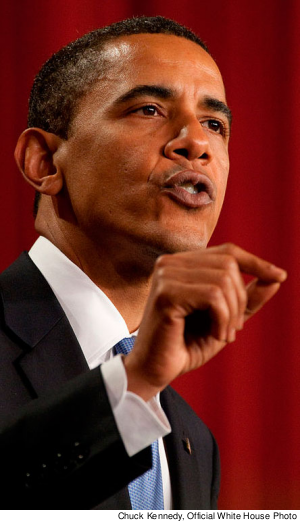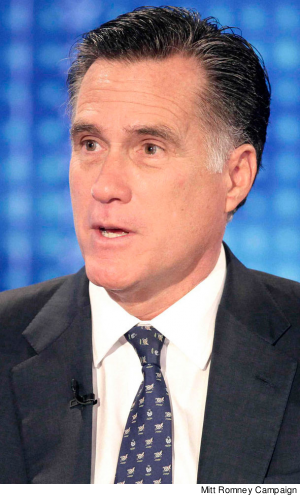Barack Obama spent 12 years as a faculty member at the University of Chicago. Mitt Romney spent 18 years as a partner in Bain Capital. Their divergent views on government’s role in college education may in part reflect these personal histories.
 |
But whatever their origins, today the candidates’ views on higher education funding are a strikingly consistent expression of the difference in their political philosophies. Romney’s policies are based on his faith in profit-seeking institutions and mistrust of government. Obama advocates a robust federal role in supporting both access and “efficiency” in college education, and he has recently proposed a college-level “Race to the Top” fund to promote policy change toward those goals.
Until 2010, 75% of federally guaranteed student loans were made by private banks, which received a subsidy for doing so. Repayment was guaranteed by the taxpayers. As Education Secretary Arne Duncan told reporters, “Essentially, we give the banks our money, and they lend it back out to students with interest, and if the students can’t pay, we pick up the tab.”
The 2010 Health Care and Education Reconciliation Act eliminated guaranteed federal repayment of student loans made by private financial institutions. All federal student loans since July 1, 2010, have instead been direct loans, funded by the federal government and serviced by private companies under contract with the Department of Education. The Congressional Budget Office estimated the resulting cost savings at $68 billion over 11 years.
PELL GRANTS
Those savings have been applied to a range of initiatives, such as increasing Pell grants. In the 2013-14 school year, the maximum annual Pell grant will increase to $5,635, up 19% since Obama was elected. Future increases are tied to the Consumer Price Index. The White House said the reform had funded “the largest investment in student aid since the GI Bill.”
 |
Romney strongly opposed the shift to direct federal loans, which he has labeled a “nationalization.” He vows to reverse it if elected, and return to reliance on private banks.
He proposes to “refocus” Pell grants to target the neediest students, without offering specifics. The budget plan of Romney’s running mate, Rep. Paul Ryan – which Romney described as “excellent work” – would shrink the average Pell grant and limit Pell grant eligibility: according to the nonprofit Education Trust, about 1 million fewer students would qualify.
In a March 5, 2012 campaign stop in Mahoning Valley, Ohio, Romney told a high school student not to expect federal help with college costs. “I know that it would be popular for me to stand up and say I’m going to give you government money to make sure you pay for your college. But I’m not going to promise that,” Romney said. “What I’m going to tell you is shop around, get a good price…. Don’t take on too much debt, and don’t expect the government to forgive the debt that you take on.” This was not a wayward comment in the heat of the campaign: a Romney policy paper cites increased Pell grant funding as a key example of “the expanding entitlement mentality.”
The Obama administration has backed a limited loan forgiveness plan: its income-based repayment program currently caps student loan payments at 10% to 15% of discretionary income, and forgives loan balances after borrowers have made the income-based payments for 25 years (or 10 years for workers in public service).
The president has also asked Congress to make the American Opportunity Tax Credit permanent. The credit, which is set to expire this year, provides up to $10,000 to students and families over four years of college attendance. Romney’s tax proposal would let this credit expire, affecting 9.4 million students and families.
COMMUNITY COLLEGES
The Obama administration’s current budget proposal calls for “doubling the number of work-study jobs” for college students, with an increase of 700,000 positions over five years. In contrast, Romney would reduce work-study slots by 129,000.
The president has advocated for the importance of the country’s community colleges, often with a focus on job training. His administration has dedicated $2 billion over four years to support community college partnerships with businesses, providing skills training for in-demand occupations. Obama’s proposed 2013 budget would include an additional $8 billion over three years for similar efforts. Romney rarely speaks about community colleges: his main policy paper on education mentions them only once.
Obama supports and Romney opposes the Dream Act, which would make many undocumented immigrant students eligible for student loans, work-study, and in-state tuition rates. As governor, Romney vetoed a bill that would have allowed undocumented immigrants who had graduated from a Massachusetts high school to attend UMass at in-state rates. (The PSC was leading member of a coalition that successfully campaigned for a similar bill in New York.)
On tuition, the Obama administration declares that “declining state support for postsecondary education…is the primary driver of tuition increases at public institutions of higher education,” and it emphasizes that public universities educate 70% of US students. “Even in nominal dollars,” the White House observes, “state funding for higher education fell in more than 40 states between 2011 and 2012.” President Obama has urged the National Governors’ Association to reverse this trend and instead increase state funding for college education. Beyond this public advocacy, the administration is now proposing to condition some direct federal aid on whether states are “making a consistent financial commitment to higher education,” to provide an incentive to “maintain adequate levels of funding” rather than repeated cuts.
Romney has expressed no concerns about falling state funding for public higher education. When Romney was governor of Massachusetts, such budget cuts were his policy: between 2003 and 2007 Romney reduced public support for the UMass system by $140 million, a cutback of 14%. Tuition and fees rose by 63% in the same period – before the 2008 economic crash.
Romney’s analysis of rising tuition costs does not discuss his experience as governor. Instead, the Romney campaign says that tuition is going up because of too much federal aid: “Flooding colleges with federal dollars only serves to drive tuition higher,” his position paper declares. “Mitt Romney understands that more spending is the last thing our schools need.” Accordingly, Romney’s solution to rising tuition is simple: cut direct federal aid, urge consumers to make careful, cost-conscious choices, and rely on market forces to eventually drive tuition down.
The Obama administration does not entirely disagree that unrestricted federal aid, could to some degree be a driver of college costs, especially at private institutions. It has proposed revising the formula for distributing campus-based federal aid in programs such as such as Supplemental Educational Opportunity Grants and Perkins Loans to shift dollars away from schools with rising tuition and toward schools that keep tuition controlled, provide “good value” and increase degree completion by low-income students.
RACE TO THE TOP
In this vein, Obama has recently proposed a $1 billion “Race to the Top” for college affordability and completion – and many CUNY faculty and staff are likely to have a split reaction to this new proposal. It would push states to maintain public funding for higher education and limit tuition hikes, departing from the decades-long national trend toward less public funding and increased reliance on student tuition. But the Obama administration also contends that policies on “credit transfer, remediation and course completion can also increase college costs” by preventing students from following the “most efficient” route to a degree. Its proposed college-level Race to the Top would “help students waste fewer credits and finish faster,” as a White House fact sheet puts it. This cost-cutting analysis is similar in many ways to the CUNY administration’s description of its Pathways initiative, which has been strongly opposed by the PSC and elected faculty bodies.
In K-12 education, Obama’s Race to the Top programs have angered many teachers, who argue that they promote a narrowing of education and an emphasis on “teaching to the test.” AFT President Randi Weingarten acknowledged as much when she spoke of the union’s endorsement of Obama at the AFT convention in July, 2012.
“Do we believe that this administration has put too much of a focus on testing and competition? Yes. And we will continue to push back,” Weingarten said. “But we must recognize that President Obama’s stimulus efforts in 2009 were a lifeline for public education and public services…. President Obama is working to make college more affordable, and to crack down on for-profit colleges and their deceptive practices, which are more likely to hand students a pile of debt than an actual degree.”
FOR-PROFIT
For-profit colleges account for only 12% of all students in US higher education, but nearly 50% of all student loans in default. Overall, they charge higher tuition than nonprofit schools but have lower graduation rates. Critics like Rep. George Miller have said that too many of these “proprietary” schools are characterized by “overpriced tuition and predatory recruiting practices,” often granting degrees of questionable value. Miller cites a recent study of 30 for-profit education companies, which found that on average they spent a greater share of revenue on marketing (23%) than on instruction (17%).
Obama has supported tighter rules on for-profit schools in order to discourage such abuses – for example, requiring at least 35% of former students to be currently repaying their loans. Challenged in court by an association of for-profit schools, the new rules were partially struck down in 2012. Romney said Obama had imposed ill-advised regulations that “made it even harder for some providers to operate while distorting their incentives.”
In fact, Romney sees an expanded role for for-profit institutions as a key part of the solution to rising tuition costs. His campaign says that to achieve lower tuition, government should “encourage market entry by innovative new education models,” such as for-profit schools, and that regulations like the gainful employment rule will discourage such new players in the education market.
As an example of this kind of innovative institution, helping to “hold down the cost of education,” Romney has repeatedly cited Florida’s for-profit Full Sail University. But “Mr. Romney did not mention the cost of tuition at Full Sail, which runs more than $80,000, for example, for a 21-month program in ‘video game art,’” The New York Times reported earlier this year. Nor did Romney mention that Full Sail’s well-paid CEO was chair of his campaign’s state fundraising group in Florida. He has company: USA Today reports that for-profit higher education has been a major contributor to the Romney campaign.
______________________________
RELATED COVERAGE:
How Higher Ed Cuts Undermine Us All: Analysis of “The Great Cost Shift”

